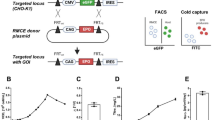Abstract
Chinese Hamster Ovary (CHO) cells are widely used for the large scale production of recombinant biopharmaceuticals. Growth of the CHO-K1 cell line has been demonstrated in serum-free medium containing insulin, transferrin and selenium. In an attempt to get autocrine growth in protein-free medium, DNA coding for insulin and transferrin production was transfected into CHO-K1 cells. Transferrin was expressed well, with clones secreting approximately 1000 ng/106 cells/24h. Insulin was poorly expressed, with rates peaking at 5 ng/106 cells/24h. Characterisation of the secreted insulin indicated that the CHO cells were incompletely processing the insulin molecule. Site-directed mutagenesis was used to introduce a furin (prohormone converting enzyme) recognition sequence into the insulin molecule, allowing the production of active insulin. However, the levels were still too low to support autocrine growth. Further investigations revealed insulin degrading activity (presumably due to the presence of insulin degrading enzymes) in the cytoplasm of CHO cells. To overcome these problems insulin-like growth factor I (instead of insulin) was transfected into the cells. IGF-1 was completely processed and expressed at rates greater than 500 ng/106cells/24h. In this paper we report autonomous growth of the transfected CHO-K1 cell line expressing transferrin and IGF-1 in protein-free medium without the addition of exogenous growth factors. Growth rates and final cell densities of these cells were identical to that of the parent cell line CHO-K1 growing in insulin, transferrin, and selenium supplemented serum-free media.
Similar content being viewed by others
References
Butler M (1986) Serum-free media. In: Thilly WG (ed.) Mammalian Cell Technology. (pp. 91–108) Butterworths, Boston.
Chen C and Okayama H (1987) High-efficiency transformation of mammalian cells by plasmid DNA. Mol Cell Biochem 7: 2745–2752.
Dai Z, Takahashi S-T, van Wyk JJ and D'ercole AJ (1992) Creation of an autocrine model of insulin-like growth factor-I action in transfected FRTL-5 cells. Endocrinology 130: 3175–3183.
Evans VJ, Bryant JC, Fioramonti MC, McQuilkin WT, Standford KK and Earle WR (1956) Studies of nutrient media for tissue C cells in vitro. A protein-free chemically defined medium for cultivation of strain L cells. Cancer Res 16: 77–86.
Gasser F, Mulsant P and Gillois M (1985) Long-term multiplication of the Chinese Hamster Ovary (CHO) cell line in serum-free medium. In Vitro cell Devel Biol 21: 588–592.
Groskrentz DJ, Sliwkowski MX and Gorman CM (1994) Genetically engineered proinsulin constitutively processed and secreted as mature, active insulin. J Biol Chem 269: 6241–6245.
Hamilton WG and Ham RG (1977) Clonal growth of Chinese Hamster cell lines in protein-free media. In Vitro 13: 537–547.
Hunt SMN, Pak SCO, bridges M, Gray PP, Sleigh MJ (submitted for publication).
Mendiaz E, Mamounas M, Moffett J and Engleberg E (1986) A defined medium for and the effect of insulin on the growth, amino acid transport, and morphology of Chines Hamster Ovary cell, CHO-K1 (CCL 61) and the isolation of insulin ‘independent’ mutants. In Vitro Cell Devel Biol 22: 66–74.
Pietrzkowski Z, Lammers R, Carpenter G, Soderquist AM, Limardo M, Phillips PD, Ullrich A and Baserga R (1992) Constitutive expression of insulin-like growth factor-I and insulin-like growth factor-I receptor abrogates all requirement for exogenous growth factors. Cell Growth and Differentiation 3: 199–205.
Podlecki DA, Frank BH and Olefsky JM (1984) In Vitro characterisation of biosynthetic human proinsulin. Diabetes 33: 111–116.
Quin D, Orci L, Ravazzola M and Moore H-PH (1991) Intracellular transport and sorting of mutant human proinsulins that fail to form hexamers J Cell Biol 113: 987–996.
Sambrook J, Fritsch EF and Maniatis T (1989) Detection and analysis of proteins expressed from cloned genes. In: Irwin N, Ford N, Nolan C and Fergusin M (ed) Molecular cloning. A laboratory manual, 2nd edition. (vol 3, p 18.74). Gold Springs Harbor Laboratory Press, USA.
Vollenweider F, Irminger J-C, Cross DJ, Villa-Komaroff L and Halban PA (1992) Processing of proinsulin by transfected Hepatoma (FAO) cells. J Biol Chem 267: 14629–14636.
Watanabe T, Nakagawa T, Ikemizu J, Nagahama M, Murakami K and Nakayama K (1992) Sequence requirements for precursor cleavage within the constitutive secretory pathway. J Biol Chem 267: 8270–8274.
Yanagita M, Nakayama K and Takeuchi T (1992) Processing of mutated proinsulin with tetrabasic cleavage sites to bioactive insulin in the non-endocrine cell line, COS-7. FEBS Letters 311: 55–59.
Author information
Authors and Affiliations
Rights and permissions
About this article
Cite this article
Pak, S.C.O., Hunt, S.M.N., Bridges, M.W. et al. Super-CHO—A cell line capable of autocrine growth under fully defined protein-free conditions. Cytotechnology 22, 139–146 (1996). https://doi.org/10.1007/BF00353933
Issue Date:
DOI: https://doi.org/10.1007/BF00353933




